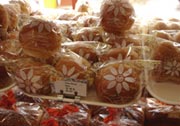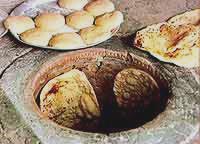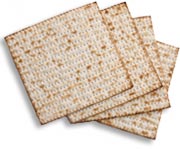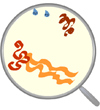
|
|
Chinese
Taro Root Buns
|
From
Chinese
baozi
to Armenian
lavash,
bread
comes in thousands of forms. What do they have in common?
On the most basic level, they all involve cooking a
mixture of milled grains and water.

|
|
Armenian
lavash
|
Imagine
a continuum of breads, ranging from the thinnest flatbreads
to the fluffiest
brioche.
Some are amazingly
simple:
Matzoh,
for example, is nothing more
than flour and water, baked until crisp. Raised breads,
on the other hand, involve the complex interactions
between flour and the leaveners that give them their
porous, tender quality.
Leaveners
come in two main forms: baking powder or soda and yeast.

|
|
Matzoh
|
Baking
powder or baking soda work quickly, relying on chemical
reactions between acidic and alkaline compounds to produce
the carbon dioxide necessary to inflate dough or batter
(more on this later). Baking powder and baking soda
are used to leaven baked goods that have a delicate
structure, ones that rise quickly as carbon dioxide
is produced, such as quick breads like cornbread and
biscuits.

|
|
Saccharomyces
cerevisiae,
or baker's yeast. Photos courtesy
of Peter Hollenhorst and Catherine Fox.
|
Yeast,
on the other hand, is a live, single-celled fungus.
There are about 160 species of yeast, and many of them
live all around us. However, most people are familiar
with yeast in its mass-produced form: the beige granules
that come in little paper packets. This organism lies
dormant until it comes into contact with warm water.
Once reactivated, yeast begins feeding on the sugars
in flour, and releases the carbon dioxide that makes
bread rise (although at a much slower rate than baking
powder or soda). Yeast also adds many of the distinctive
flavors and aromas we associate with bread. For more
on yeast, check out our fun
yeast
activity
.
But
leavening agents would just be bubbling brews without
something to contain them. Here’s where flour comes
in. There are lots of different types of flour used
in bread, but the most commonly used in raised bread
is wheat flour. This is because wheat flour contains
two proteins,
glutenin
and
gliadin
, which,
when combined with water, form gluten. As you knead
the dough, the gluten becomes more and more stretchy.
This gum-like substance fills with thousands of gas
bubbles as the yeast goes to work during rising.

|
|
|
To
learn more about gluten, check out the
gluten
animation
.
Starch,
a carbohydrate that makes up about 70% of flour
by weight, also gets in on the act. When starch granules
are attacked by enzymes present in flour, they release
the sugars that yeast feeds on. Starch also reinforces
gluten and absorbs water during baking, helping the
gluten to contain the pockets of gas produced by the
yeast.
Sometimes,
a baker will let the dough rise several times, allowing
the gluten to develop more completely and the yeast
to add more of its flavors. When the dough is finally
cooked—either in an oven, over a fire, or in a
steamer, depending on what kind of bread you
’
re
baking—the yeast inside it continues feeding, and
the pockets of gas in the dough continue to expand.
As the temperature of the cooking dough rises, the yeast
eventually dies, the gluten hardens, and the dough solidifies.
Et voilà! Bread!
For
more about bread science, check out these
links
!
|





